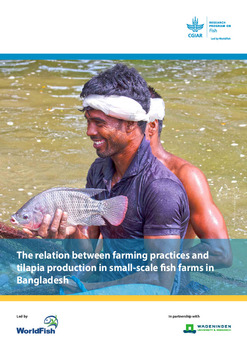The relation between farming practices and tilapia production in small-scale fish farms in Bangladesh

Citation
Tran, K. et al. (2019). The relation between farming practices and tilapia production in small-scale fish farms in Bangladesh. Penang, Malaysia: CGIAR Research Program on Fish Agri-Food Systems. Program Report: FISH-2019-06
Because of its climate and vast water resources, Bangladesh is highly suitable for fisheries. Unsurprisingly, fisheries supply the majority of animal protein (60%) in Bangladeshi diets and provide employment to over 17 million people. In the past 10 years, fish production in Bangladesh increased 5.4% annually, mainly because of aquaculture, which grew 8.2% per year. Aquaculture is considered the key supplier of animal protein for the future in Bangladesh. However, even though aquaculture production is increasing, the knowledge of farmers on culture practices is often limited. To improve and increase aquaculture production in Bangladesh, targets have been set in the government’s Seventh Five Year Plan to further develop the fisheries sector, ensure food security and produce a surplus production for export. This study was developed as part of the CGIAR Research Program on Fish-Agri-Food Systems (FISH), in an attempt to analyze current farming practices in order to identify risks for diseases and opportunities for higher production. In this way, the study could contribute to the development of better management practices for small-scale fish farming in Bangladesh. As Nile tilapia (Oreochromis niloticus) is considered one of the most promising aquaculture species, the focus in this report is on tilapia farmers. Various farming practices were investigated by conducting interviews with tilapia farmers in different regions of the country. The collected data and the observations on the farms were used to identify practices that could improve and increase tilapia production in Bangladesh by comparing practices and production outputs among the assessed farms.
Permalink
Date Available
Type
Publisher
Countries
Copyright
CC BY 4.0
Research Themes
Topics
Language